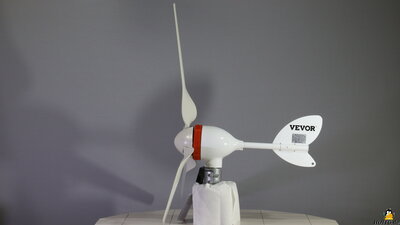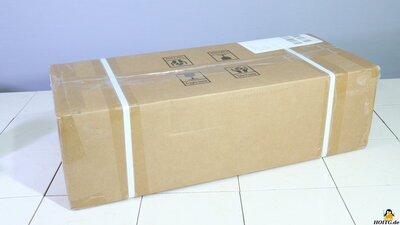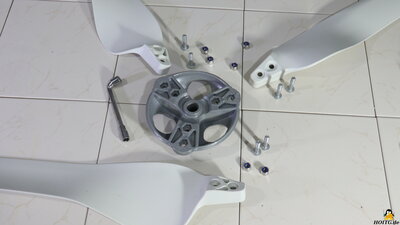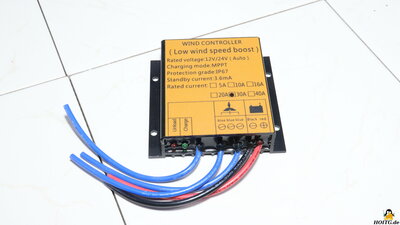| <<< Imprint | ...to be continued. >>> |
Wind turbine FT-400 from VEVOR
The gadget in moving pictures with audio
Visit the VEVOR online shops to see all tools on offer:
FT-400 on vevor.com
All wind turbines on vevor.com
Vevor.com with warehouses in the US, EU, UK, DE
5% off on ALL products on vevor.com with the code: VVMH5%OFF
VEVOR on Amazon US
VEVOR on Amazon UK
VEVOR on Amazon DE
By purchasing via the specified affiliate links, you support HOITG without any additional costs for you - thanks!
How open is this Gadget?
| Category | Remark | Info |
|---|---|---|
| Firmware |
No firmware implemented. |
? |
| Software |
No additional software needed. |
? |
| Hardware |
The turbine is composed of only a few parts and can be disassembled. |
? |
| Elektronik |
The charge controller is encapsulated in plastic, but it is a common spare part. |
? |
| Website |
No spare parts offered by VEVOR! |
? |
| Patente |
As far as I know, no patents are claimed. |
? |
The gadget in Detail
Figure 1:The wind turbine type FT-400 is offered by the company Vevor. The 3-blades rotor has a diameter of 1.30m. The turbine is advertised with a power output of up to 400W. With the included controller, 12 or 24V lead-acid batteries can be charged independently of a mains power supply.
The wind turbine thus allows the operation of low power devices in remote areas or can make a small positive contribution to the energy bill of a household.
Technical data
| Category | Value | Remark |
|---|---|---|
| Dimensions |
1300x650mm |
Rotor diameter x Length |
| Weight |
8000g |
|
| Power | 400W | |
| Batteries | 12 or 24V Lead-acid batteries | |
| Laderegler | Bis 30A |
Package contents
Figure 2:The wind turbine is delivered in a compact box with a total weight of just over 8kg.
Assembly
Figure 3:The tools required to assemble the rotor blades are included. These are made of Nylon and must be bolted to the rotor hub. Two 6mm screws with self-locking nuts are used for each rotor blade. After that, the hub is attached to the 15mm shaft of the rotor with another self-locking nut - and yes, later I tightened the nut correctly, without the camera in the way. The cap snaps in place on the rotor hub.
Components
Figure 4:The front part of the turbine with the rotor is attached to the housing with four 5mm screws. The rotor shaft is pressed into a bearing with two rows of balls type 3203B at the front part of the housing. A rubber ring seals the two components.
12 permanent magnets are attached to the rotor. The coils, wound with copper wire are located on the stator of the turbine - the iron core of these is press fitted into the housing.
Since the turbine housing has to rotate in order to optimally align the rotor with the wind direction, there are 3 sliding contacts at the upper end of the axis. These are composed of brass rings with carbon brushes and forward the generated energy to the outside via three cables in the center of the axis.
The very rigid turbine housing and the sheet metal of the wind vane are made of aluminum.
A second ball bearing enables the turbine to rotate.
Electronics
Figure 5:The three cables of the turbine must be connected to the charge controller. This part of the electronics is cast in a plastic block and is therefore protected from harsh weather conditions. Two more cables must be connected to a 12 or 24V lead-acid battery. The included controller is designed for a maximum current of 30A and automatically detects whether a 12 or 24V lead-acid battery is connected. An integrated step-up converter ensures that the battery is charged even at low rotor speeds.
My conclusion
hat can the Vevor FT-400 do in practice?To answer this question, I will attach sensors to the turbine, which will measure, amongst other things, the rotor speed, the alignment of the turbine housing and the charging capacity of the lead-acid battery. The gained data is transmitted live to the Internet and so accessible to all people interested in the results. The chapter on that conversion process will be published on me secon project HomoFaciens - have a click!
| <<< Imprint | ...to be continued. >>> |




